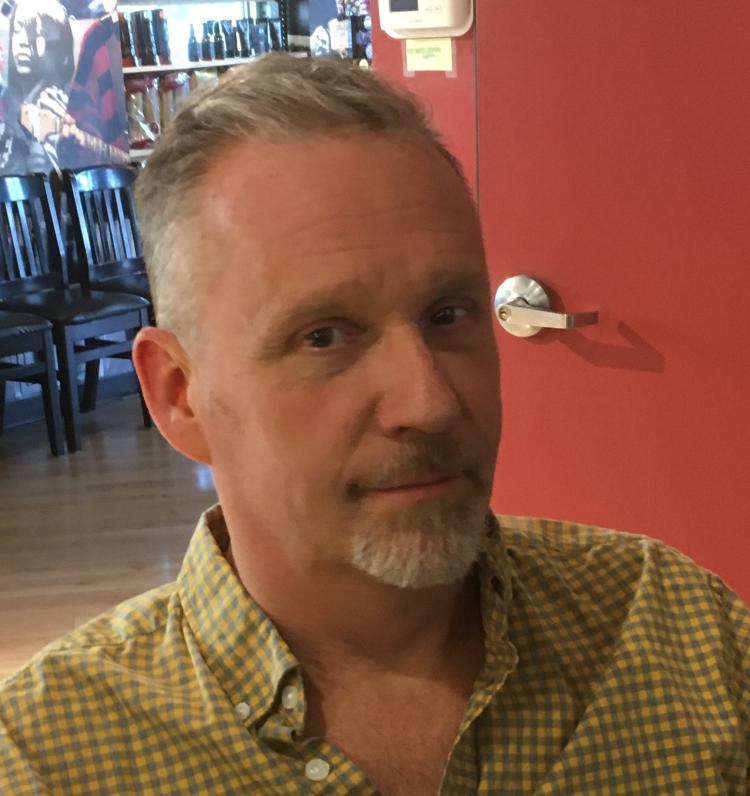Rigorous skill-building is just the first act for theatre and dance students
Whether it’s utilizing the costume shop, scene shop or the movement studio, theatre and dance students are putting what they learn in the classroom to practice
Putting on a performance is more than just being on stage. It requires intricate preparation—which in turn, requires space.
Sciences such as physics, biology and chemistry depend on the classic type of laboratory for their experimental study and rigorous testing, but for students in the Department of Theatre and Dance, those spaces look a little different.

At the top of the page: Two students building a mannequin in a theatre shop (Patrick Campbell). Above: Ted Stark.
A recent walk through the halls of the University Theatre Building revealed students in classes building Adirondack chairs or making plaster masks in the scene shop, and painting cartoon images on silk in the costume shop.
In all these spaces, students take the theories they’re exposed to in classroom lectures and put them into practice during production season. Working on projects both big and small enables them to understand how practicality applies in the creation of art.
“Our classes use a different set of tools, and we have a different objective, but the research and effort that these students put into earning their degree is equivalent to what’s going on in all of the other departments,” said Ted Stark, senior instructor and director of undergraduate studies in theatre and dance, adding:
“We encompass all of the departments on campus. … If, for example, you are working as a costume designer or a scenic designer, sure you need to be able to paint and draw. But a scenic design, for example, also includes engineering skills, sophisticated physics and mathematics. It includes a lot of art history and sociological research on costumes. There’s a lot of psychological research, historical context and kinesthetic learning. These valuable teaching tool send students into the world with a well-rounded education.”
As students move through the personal and professional areas of their lives, they must take many different approaches they must take to individual and collective problems to success succeed—whether it’s maintaining a household or serving an employer.
“We’re not preparing students for a singular career path,” Stark said. “We’re giving them a lot of tools for their educational toolbox. In this day and age, it’s important to be able to pivot in their careers. The things students are learning for theatre can be applied to other areas of their lives.”

Student building a costume in the costume shop (Patrick Campbell).
Here are three of those students:
Emily Ray is a senior and will graduate in May with a double major in theatre and history with a minor in Nordic studies. She’s working on an independent study that includes a dye project and an honors thesis on textiles and women in medieval Iceland.
“I’m curious about how people made dyes before there were synthetic dyes,” she said. “I grew some plants in my garden over the summer, like woad that makes blue dye. Figuring out how to make dye from the plants and then using the dye on costumes was a practical application of my history honors thesis.”
Natalie Connelly is a junior with a double major in acting and psychology.
“I’m in an advanced movement class,” she said. “It focuses on physical movement and theatre. I chose CU because of the flexibility of the programs here. I was interested in both psychology and theatre, and a lot of theatre programs I was looking into at other colleges would only let me major in theatre, whereas here it’s flexible enough that I could do two different degrees at the same time.”
Nikky Haabestad is a sophomore, majoring in design technology management in the BFA program with a focus on props.
“I was mentored by a senior last year and took over the prop shop when that person graduated,” she said. “I organize the props we keep in our storage space, and I teach other people how to do props. I came here without a specific focus. I didn’t know what area I wanted to go into specifically. But I had a lot of skills from various other areas. I decided to try out props since it’s different all the time. On any given day I do woodworking, sewing, metals, fabrication, use lots of hot glue, casting and scrapbooking. It’s fun because you get to do something different all the time.”

